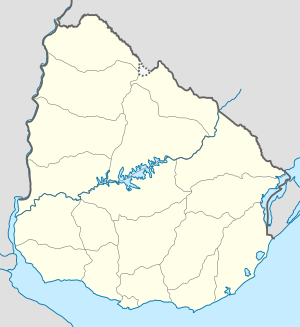|
2009–10 Uruguayan Primera División season
The 2009–10 Liga Profesional de Primera División season, also known as the 2009–10 Copa Uruguaya or the 2009–10 Campeonato Uruguayo, was the 106th season of Uruguay's top-flight football league, and the 79th in which it was professional. The season was named in honor of Héctor del Campo, ex-president of Danubio. FormatThe season was divided into two tournaments: the Apertura and the Clausura. In each tournament, the teams played against each other in a single round-robin format. Whoever plays at home against an opponent in the Apertura played the same opponent as a visitor in the Clausura. The champion of the Copa Uruguaya could have been decided in three ways:
RelegationRelegation was determined by an aggregate table of the past two seasons. The teams who had participated only in this season had their points and goal difference multiplied by two. The three lowest-placed teams were relegated to the Segunda División Profesional for the next season. International qualificationBecause of Uruguay's qualification to the 2010 FIFA World Cup, there was no Liguilla Pre-Libertadores this season. The champion of the Copa Uruguaya earned the Uruguay 1 berth in the 2011 Copa Libertadores and 2010 Copa Sudamericana. The Copa Uruguaya runner-up earned the Uruguay 2 berth in the 2011 Copa Libertadores. The Uruguay 3 berth for the 2011 Copa Libertadores went to the highest-placed non-qualified team in the aggregate table. The Uruguay 2 and Uruguay 3 berths for the 2010 Copa Sudamericana went to the next highest-placed non-qualified teams in the aggregate table. TeamsSixteen teams competed in the Primera División this season. Thirteen teams remained from the 2008–09 season. Villa Española was relegated last season after the Apertura tournament due to financial reasons. They were joined by Juventud and Bella Vista, who finished 14th and 15th in the relegation table, respectively. These three teams were replaced by Fénix and Cerrito, the 2008–09 Segunda División winner and runner-up, respectively, and Atenas, the Segunda División playoff winner. Both Fénix and Cerrito are returning to the Primera División while this is Atenas' first season in the top-flight. Torneo AperturaThe Torneo Apertura "Coronel Matías Vázquez" began on August 23, 2009 and ended on December 13, 2009. Standings
Updated to match(es) played on December 13, 2009. Source: AUF
Rules for classification: 1st points; 2nd goal difference; 3rd goals scored; 4th head-to-head results; 5th draw Notes: ResultsTop-ten goalscorers
Updated as of games played on December 13, 2009. Torneo ClausuraThe Torneo Clausura "Dr. Walter Lanfranco" began on January 23. Standings
Updated to match(es) played on 2 May 2010. Source: AUF (in Spanish)
Rules for classification: 1st points; 2nd goal difference; 3rd goals scored; 4th head-to-head results; 5th draw ResultsTop-ten goalscorers
Source: AUF (in Spanish) Aggregate table
Updated to match(es) played on May 2, 2010. Source: AUF Rules for classification: 1st points; 2nd goal difference; 3rd goals scored; 4th head-to-head results; 5th draw Notes: Season topscorers
Source: AUF (in Spanish) Relegation table
Updated to match(es) played on May 2, 2010. Source: AUF Rules for classification: 1st points; 2nd goal difference; 3rd goals scored; 4th head-to-head results; 5th draw (R) Relegated Notes:
Championship playoffsNacional and Peñarol qualified to the championship playoffs as the Apertura and Clausura winners, respectively. Additionally, Peñarol requalified as the team with the most points in the season aggregate table. Given this situation, an initial playoff was held between the two team. Peñarol needed only to win the playoff to become the season champions; Nacional had to win the playoff to force another two matches, which they successfully did.
FinalsSince Nacional won the initial playoff, an additional two matches was contested to crown the champion. The points system was used for the two matches. The team with the most points at the end of the second game was declared the champion. If there was a tie in points after the second game, goal difference would be used to break the tie, followed by two fifteen-minute extra periods, followed by a penalty shootout if necessary.
Source: [citation needed]
Rules for classification: 1st points; 2nd goal difference; 3rd extra time; 4th penalty shoot-out.
See alsoReferences
External links
|
|||||||||||||||||||||||||||||||||||||||||||||||||||||||||||||||||||||||||||||||||||||||||||||||||||||||||||||||||||||||||||||||||||||||||||||||||||||||||||||||||||||||||||||||||||||||||||||||||||||||||||||||||||||||||||||||||||||||||||||||||||||||||||||||||||||||||||||||||||||||||||||||||||||||||||||||||||||||||||||||||||||||||||||||||||||||||||||||||||||||||||||||||||||||||||||||||||||||||||||||||||||||||||||||||||||||||||||||||||||||||||||||||||||||||||||||||||||||||||||||||||||||||||||||||||||||||||||||||||||||||||||||||||||||||||||||||||||||||||||||||||||||||||||||||||||||||||||||||||||||||||||||||||||||||||||||||||||||||||||||||||||||||||||||||||||||||||||||||||||||||||||||||||||||||||||||||||||||||||||||||||||||||||||||||||||||||||||||||||||||||||||||||||||||||||||||||||||||||||||||||||||||||||||||||||||||||||||||||||||||||||||||||||||||||||||||||||||||||||||||||||||||||||||||||||||||||||||||||||||||||||||||||||||||||||||||||||||||||||||||||||||||||||||||||||||||||||||||||||||||
